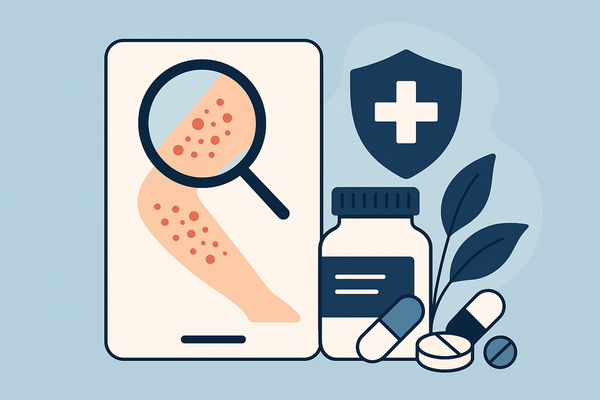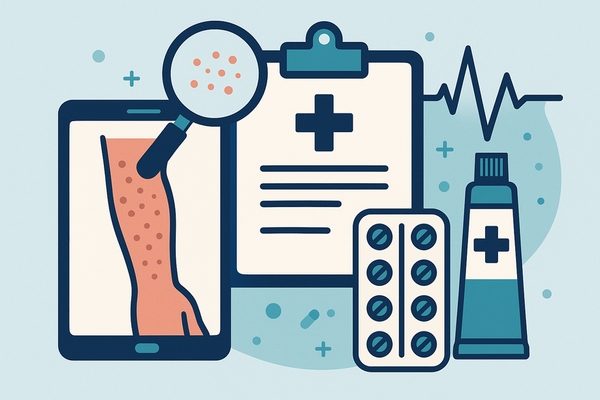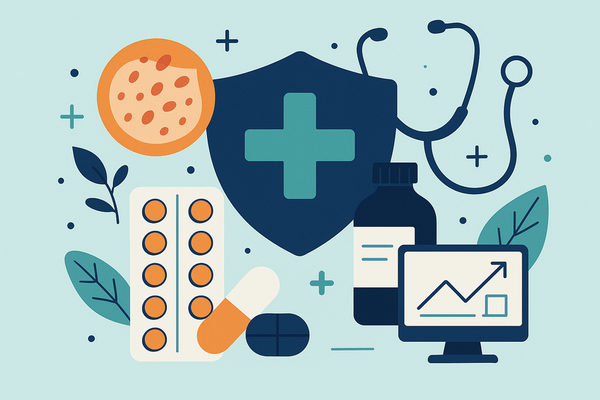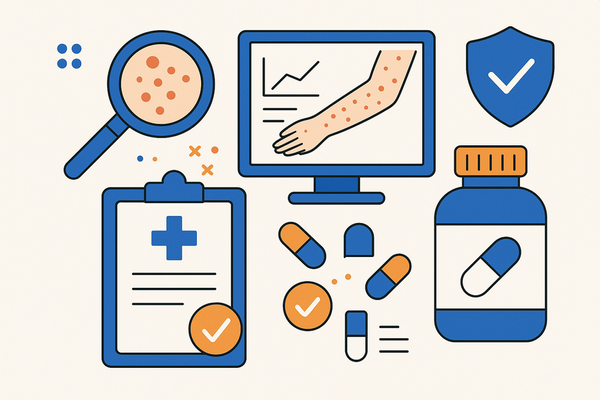Medication Rash Treatment: Identify, Manage, and Prevent Drug-Induced Rashes
Learn how to identify, manage, and prevent drug-induced rashes with our expert-backed medication rash treatment guide. Stay safe and informed.
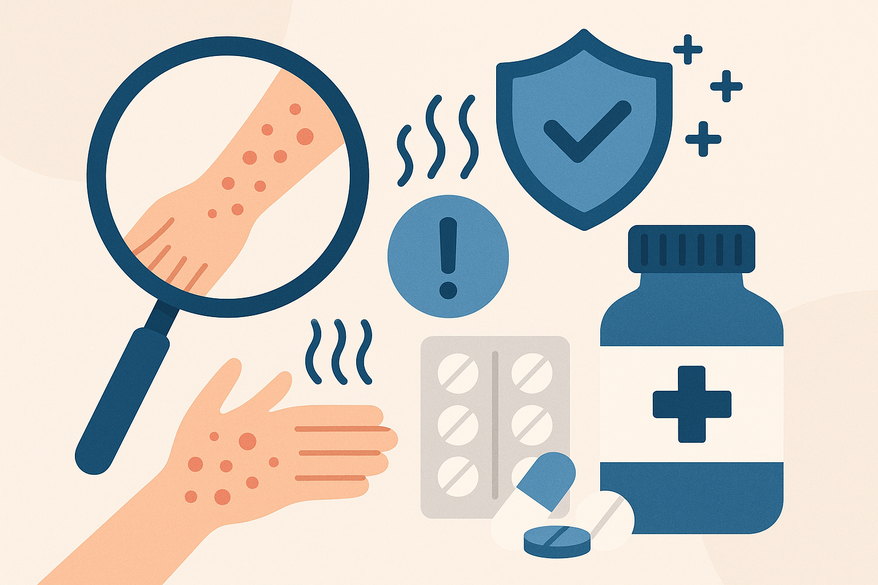
8 min read
Key Takeaways
- Early recognition of medication-induced rashes can prevent serious complications
- Accurate diagnosis relies on a thorough medication history and appropriate testing
- Treatment includes discontinuation of the culprit drug, symptomatic therapies, and supportive skincare
- Preventative measures such as allergy history, patch testing, and dosage titration reduce rash risk
Table of Contents
- What Is a Medication-Induced Rash?
- Common Culprits
- Recognizing Symptoms and Assessing Severity
- Diagnosing a Medication Rash
- Treatment and Management Options
- When to Seek Professional Help
- Preventative Measures and Risk Reduction
- Conclusion
What Is a Medication-Induced Rash?
A medication-induced rash is a skin reaction that appears days to weeks after starting a drug. It differs from viral or environmental rashes in two key ways:
- Timing: Eruptions typically emerge after exposure to a new medication.
- Patterns: Common presentations include morbilliform (measles-like) eruptions, urticaria (hives), or fixed drug eruptions.
Mechanisms of Medication Rashes
- Allergic Reactions
- Type I (IgE-mediated): Rapid onset hives, swelling, or anaphylaxis.
- Type IV (cell-mediated): Delayed contact dermatitis appearing 48–72 hours later.
- Non-Allergic Side Effects
- Direct pharmacologic toxicity affecting skin cells without immune involvement.
Understanding these mechanisms guides appropriate treatment decisions.
Common Culprits
Some drug classes carry a higher risk of skin eruptions:
- Antibiotics
- Penicillins and sulfonamides often produce morbilliform rashes.
- Anticonvulsants
- Lamotrigine and carbamazepine can trigger Stevens–Johnson syndrome.
- NSAIDs
- Ibuprofen and naproxen may cause urticaria or fixed drug eruptions.
- Allopurinol & Diuretics
- Linked to delayed hypersensitivity and complex skin lesions.
Recognizing Symptoms and Assessing Severity
Watch for early warning signs:
- Raised red or flat macules/papules
- Intense itching or burning
- Hives (urticaria)
- Blistering or peeling in severe cases
Severity Levels
- Mild Rash: Localized, minimal discomfort.
- Severe Reaction: Systemic signs like fever, mucosal ulcers, rapid spread—risk of Stevens–Johnson or anaphylaxis.
Action Steps
- Monitor skin changes daily after starting any drug.
- Keep a journal: record medication start date, rash onset, area, and intensity. For more on this, see identifying drug-induced rash symptoms.
Diagnosing a Medication Rash
At Your Doctor’s Visit
- Full Medication History: Include prescriptions, OTC drugs, and supplements with dates and doses.
- Physical Examination: Note rash pattern, distribution, and any mucosal involvement.
Diagnostic Tests
- Skin-prick or intradermal testing for IgE-mediated allergies.
- Blood tests: CBC with eosinophils; serum tryptase for mast cell activation.
- Skin biopsy for atypical or severe reactions.
Red Flags for Urgent Care
- Rapidly expanding rash or blistering
- Airway symptoms: wheezing, hoarseness
- High fever, facial swelling, extreme fatigue
Treatment and Management Options
Immediate Steps
- Discontinue the suspected medication under medical supervision.
- Symptomatic Therapies:
- Antihistamines (diphenhydramine, cetirizine) for itch and hives.
- Topical corticosteroids for localized inflammation.
- Systemic corticosteroids for widespread or severe reactions.
- Epinephrine auto-injector for anaphylaxis.
Supportive Skin Care
- Use gentle, fragrance-free cleansers.
- Apply hypoallergenic moisturizers to restore the skin barrier.
- Avoid hot water, harsh soaps, and known irritants.
Alternative Drug Options
- Switch to a different drug class with lower rash risk.
- Adjust dosage gradually to reduce hypersensitivity.
For a deeper guide, see managing drug allergy rashes.
Rash Detector is an AI-powered skin analysis app that lets you upload images and receive instant insights on potential medication-induced reactions. Rash Detector.
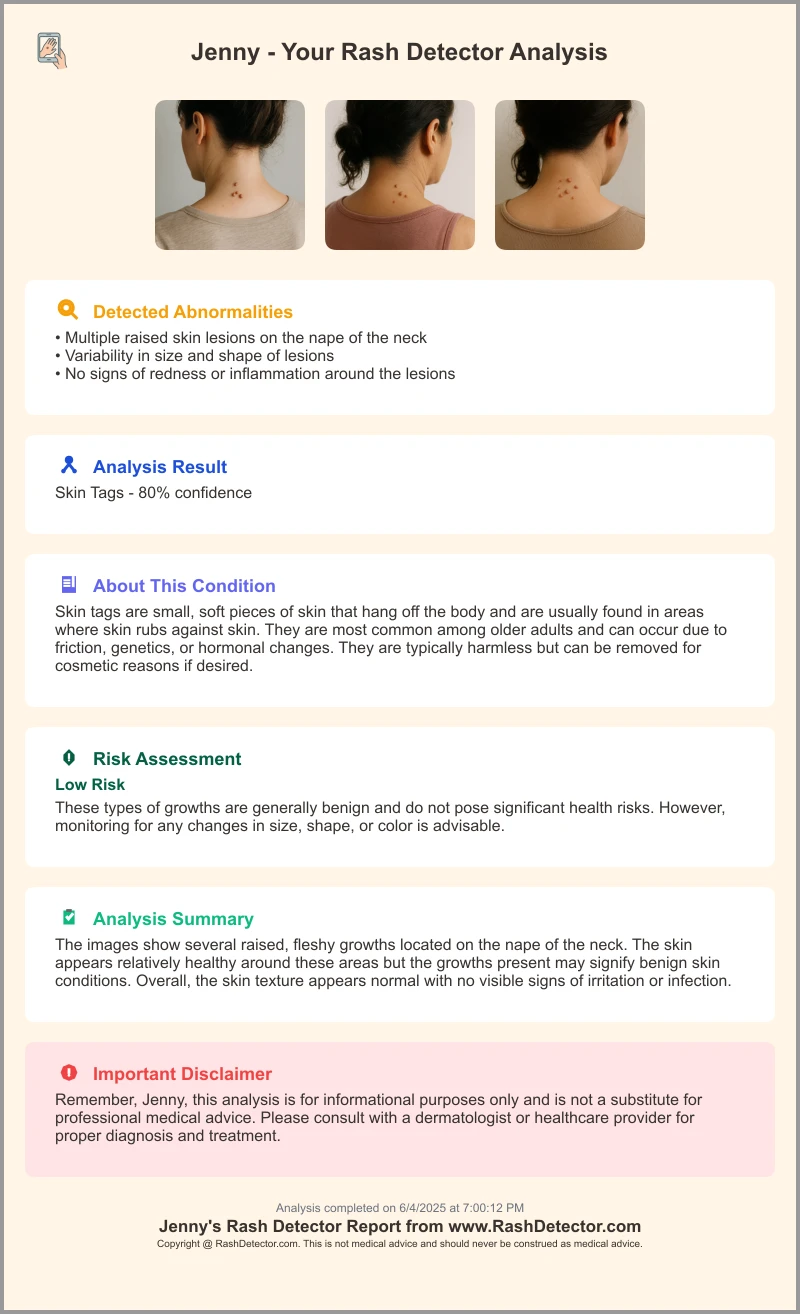
When to Seek Professional Help
Emergency Signs:
- Difficulty breathing, throat tightness
- Swelling of face, lips, or tongue
- Rapidly spreading rash with blisters or skin sloughing
- High fever, severe joint pain, or feeling very unwell
For Mild Cases:
- Contact your healthcare provider before stopping any medication.
- Continue home care if the rash remains mild and localized.
- Follow up promptly if symptoms worsen or new signs appear.
Preventative Measures and Risk Reduction
Pre-Treatment Evaluation
- Detailed Allergy History: Note past drug reactions and severity.
- Patch Testing: Identify delayed hypersensitivity before starting high-risk drugs.
- Dosage Titration: Gradual dose increases to lower rash risk.
Medication Diary
- Record every new prescription, OTC drug, and supplement.
- Note start date, dosage, and any skin changes daily.
Open Dialogue
- Discuss rash risks and warning signs with your provider.
- Agree on an action plan before beginning therapy.
Conclusion
Effective medication rash treatment relies on early recognition, precise diagnosis, and evidence-based management. By understanding causes, identifying high-risk drugs, and following clear protocols, you can minimize discomfort and prevent complications. Always consult healthcare professionals for personalized guidance and safe medication use.
FAQ
- What are the most common symptoms of a medication rash?
Look for red or raised bumps, itching, hives, and in severe cases, blistering or peeling skin. - How soon after starting a drug can a rash appear?
Rashes typically emerge within days to weeks after initiating a new medication. - When should I seek emergency care?
Seek immediate help if you experience airway symptoms, rapid rash spread, blisters, or systemic signs like high fever. - Can I prevent medication rashes?
Yes—through detailed allergy histories, patch testing, dosage titration, and maintaining a medication diary. - Are all drug rashes allergic reactions?
No—some rashes result from direct drug toxicity and do not involve the immune system.


